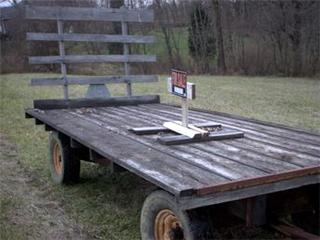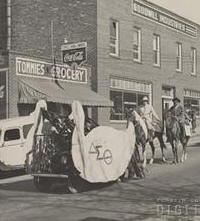Parades have been around since the dawn of civilization, and naturally, so have floats. Shortly after man invented the wheel, he began taking pride in showing off his accomplishments with a variety of mobile units designed to showcase his achievements.
 The
very first, original floats were nothing more than platforms set atop
four wheels, as men of that time were quite proud of their ability to
move along in that simple nature. Often they would jump on these
platforms and ride them, beaming proudly at the neighboring tribes. Over
time, it became commonplace for tribal leaders to select a theme for
their float, perhaps proclaiming their most recent conquests or
achievements. Occasionally, defeated enemies would be paraded alongside
the float, or their heads would be displayed for all to view.
The
very first, original floats were nothing more than platforms set atop
four wheels, as men of that time were quite proud of their ability to
move along in that simple nature. Often they would jump on these
platforms and ride them, beaming proudly at the neighboring tribes. Over
time, it became commonplace for tribal leaders to select a theme for
their float, perhaps proclaiming their most recent conquests or
achievements. Occasionally, defeated enemies would be paraded alongside
the float, or their heads would be displayed for all to view.The crucifixion theme was very common around the year 30 AD and was incorporated into several Roman parades. It was considered quite an honor to be chosen as the crucified "king" of the parade, and often many
 people would vie for this title, the lucky one chosen to represent his
city.
people would vie for this title, the lucky one chosen to represent his
city.Floats gradually grew more elaborate as the years passed by, but themes still remained popular. It seems that whatever was important to the populace at the time was represented in the way of floats in local parades. Civic leaders and celebrities were in constant demand as passengers on these floats, much as today. The pageantry has not changed over the centuries.
 The
renaissance brought out an entirely new line of themes which people
instantly incorporated into their float designs. Guillotines were in
vogue during the later years of the French revolution, and nearly all
floats from that era used one as a central part of their theme. Many of
these floats, in fact, actually performed beheadings and threw the heads
into the crowds for children to play with. This is where the modern
practice of throwing out candy from parade clowns originated.
The
renaissance brought out an entirely new line of themes which people
instantly incorporated into their float designs. Guillotines were in
vogue during the later years of the French revolution, and nearly all
floats from that era used one as a central part of their theme. Many of
these floats, in fact, actually performed beheadings and threw the heads
into the crowds for children to play with. This is where the modern
practice of throwing out candy from parade clowns originated.As civilizations modernized, horse-drawn floats became the norm. More and more you began
 to see local celebrities using these platforms as a way of
self-promotion. Brightly-colored paper and conspicuous tapestries began
to appear as everyone strived to make their float stand out among the
crowded field.
to see local celebrities using these platforms as a way of
self-promotion. Brightly-colored paper and conspicuous tapestries began
to appear as everyone strived to make their float stand out among the
crowded field. In the 20th century, floats finally achieved the appearance that they have today. Many modern-day floats are almost exact replicas of castles, houses, and even space-aged conveyances. In fact, during a recent Bell Tower festival, it was later determined that the winning float was
 actually
not a float at all, but rather a local moving company had been caught in
the process of relocating a house to another part of town. He was
allowed to keep his first place trophy, nonetheless (photo).
actually
not a float at all, but rather a local moving company had been caught in
the process of relocating a house to another part of town. He was
allowed to keep his first place trophy, nonetheless (photo).Today, the Bell Tower festival will feature class reunion floats which have come a long way since the inception of the float concept. You will find most floats still featuring a platform and
 four wheels, and as the parade slows down when turning at Chestnut and
Lincolnway, many passengers will disembark for a cold one at the local
saloon.
four wheels, and as the parade slows down when turning at Chestnut and
Lincolnway, many passengers will disembark for a cold one at the local
saloon.Rick Bland, contributor